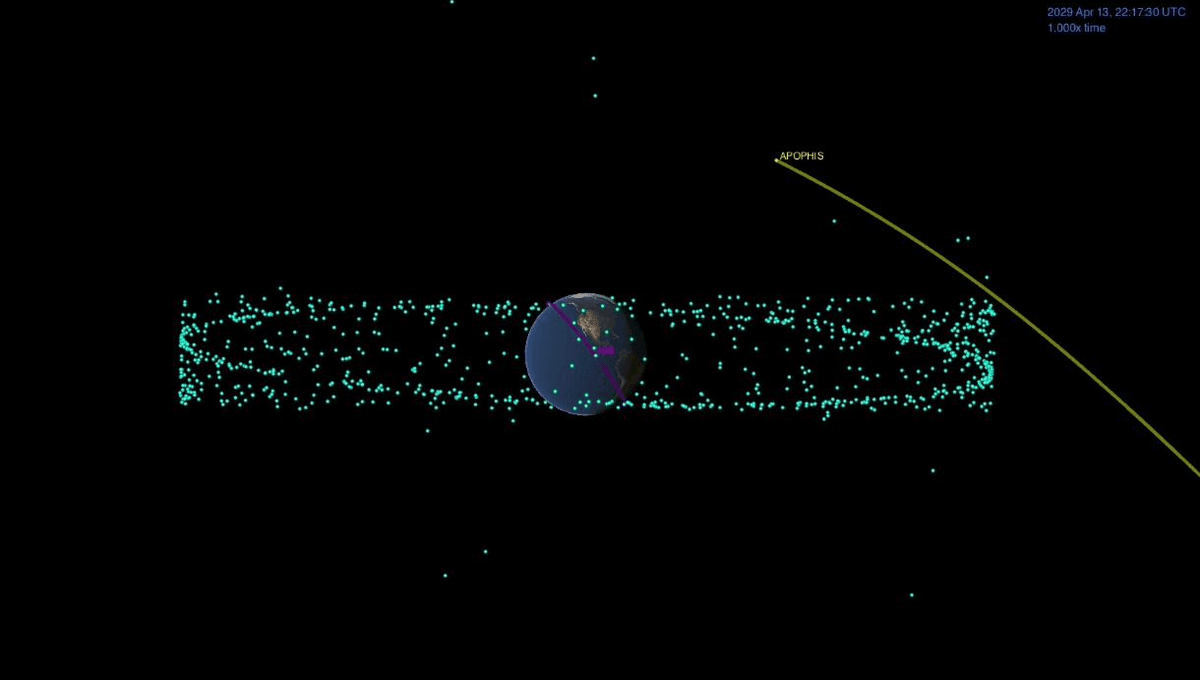
When Earth and the hazardous asteroid 99942 Apophis pass by each other in five years’ time, the passage through Earth’s gravitational well could reshape the space rock’s surface. A new paper seeks to predict what that could look like, and finds there could be both dramatic short-term effects and more subtle ones that will take much longer.
Apophis was named for the Egyptian god of destruction, because when first discovered there was considered to be a substantial chance it would hit Earth in the next century. At less than a tenth the diameter of the dinosaur killer (and therefore a thousandth the mass) Apophis wouldn’t cause a mass extinction in such a collision. However, an impact could kill millions directly, and drastically reduce food production for long enough to make much of the world starve, so the name was not given without reason.
While only a direct hit will be damaging to Earth, just encountering our gravity may trigger on Apophis what would be called earthquakes if they were happening here when the asteroid makes a close approach in 2029. Their force will cause the whole asteroid to shake powerfully enough that rocks and dust may be launched off the surface. If so, most of these will form a crowd of rubble that will eventually settle back down on Apophis. Given the exceptionally weak gravity, however, some may escape entirely.
Meanwhile, parts of the asteroid’s innards that have not been exposed to space before may now become the surface.
Debate remains about how close to a planet an asteroid must come to Earth’s center for events like this to occur, with estimates ranging from 3-16 Earth radii distance. The 2029 passage will be at 5 Earth radii. Even where dust or small stones are thrown off the asteroid entirely, many will come loose enough to slide down slopes in miniature (and very slow) avalanches.
One way to know the prospects of such events is to look at similar asteroids that may have had such encounters before. Objects without atmospheres suffer what is called “space weathering”, where the impact of micrometeorites and the solar wind changes their surfaces over time.
However, a category of asteroids known as Q-class have a different appearance to asteroids thought to have a similar composition. We haven’t had a close look at these, but a team led by Dr Ronald-Louis Ballouz of Johns Hopkins University think it is likely that Q-class asteroids are those that have had recent close encounters with an inner planet’s gravity. According to this theory, this happened recently enough that space weathering has not returned these asteroids’ surfaces to their normal state.
By looking at how many Q-class asteroids there are, planetary scientists can get an estimate of how often a resurfacing event occurs, and therefore how close objects need to pass for them to happen.
Q-class asteroids seem to be common enough to suggest these events are puzzlingly frequent, and therefore the passages required do not need to be that close. Ballouz and co-authors are seeking to explain this.
They note there are two ways a close encounter could lead to resurfacing. The one is immediate, creating the dramatic seismic events described above. Earth’s gravitational gradient is so steep at the height of 32,000 kilometers (20,000 miles) – at which Apophis will pass – that the pull on the closer part of the asteroid will be stronger than its far side, creating immense tidal forces, and quite likely seismic events. Getting to see what that will look like is the reason the OSIRIS-REx mission has been turned into OSIRIS-APEX, which will closely follow Apophis before, during, and after the event.
However, the consequences could also be longer term, and it’s possible that passage does not need to be so close for this. Like other asteroids its size, Apophis is not spherical. Consequently, it rotates at different rates around two different axes of rotation. How its close encounter with Earth will change that will depend on which side is facing Earth at closest approach – something we cannot predict this far out.
Nevertheless, it’s possible the disruption will not only shorten the asteroid’s day from 30.6 to around 21 hours, but also cause it to tumble, leading to ongoing long-term shaking. This could cause dust and small stones to slide down slopes, maintaining those slow avalanches and eventually wiping clear signs of space weathering.
After the initial fears, more detailed observations of its orbit mean we know Apophis will not hit during its next close encounter in 2029, and we are almost sure it won’t be a threat for a few lifetimes after that. Nevertheless, the odds of an eventual impact are substantial, and the more we know about Apophis, the more prepared we will be
Asteroids this large are thought to only come as close as this to Earth once every 7,500 years, so we’re very lucky, scientifically, to have this happen so soon after the birth of the space age.
The study has been accepted by the Planetary Science Journal, and a preprint is available via arXiv.
[H/T: Interesting Engineering]
Source Link: Earth’s 2029 Close Encounter With Apophis Could Create Epic "Asteroidquakes"